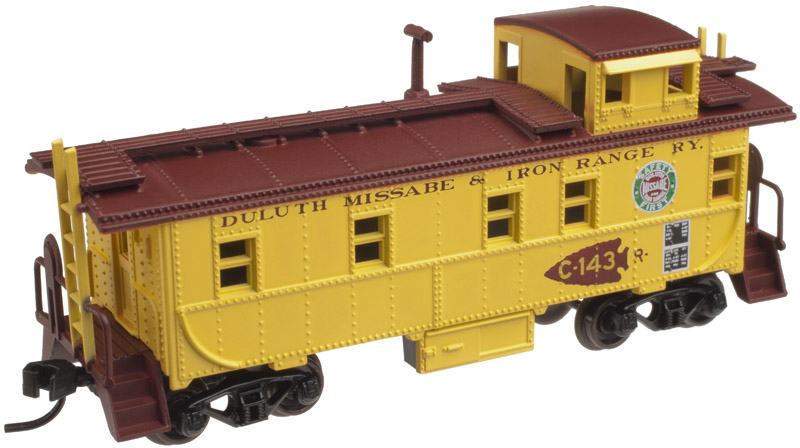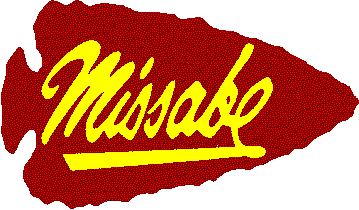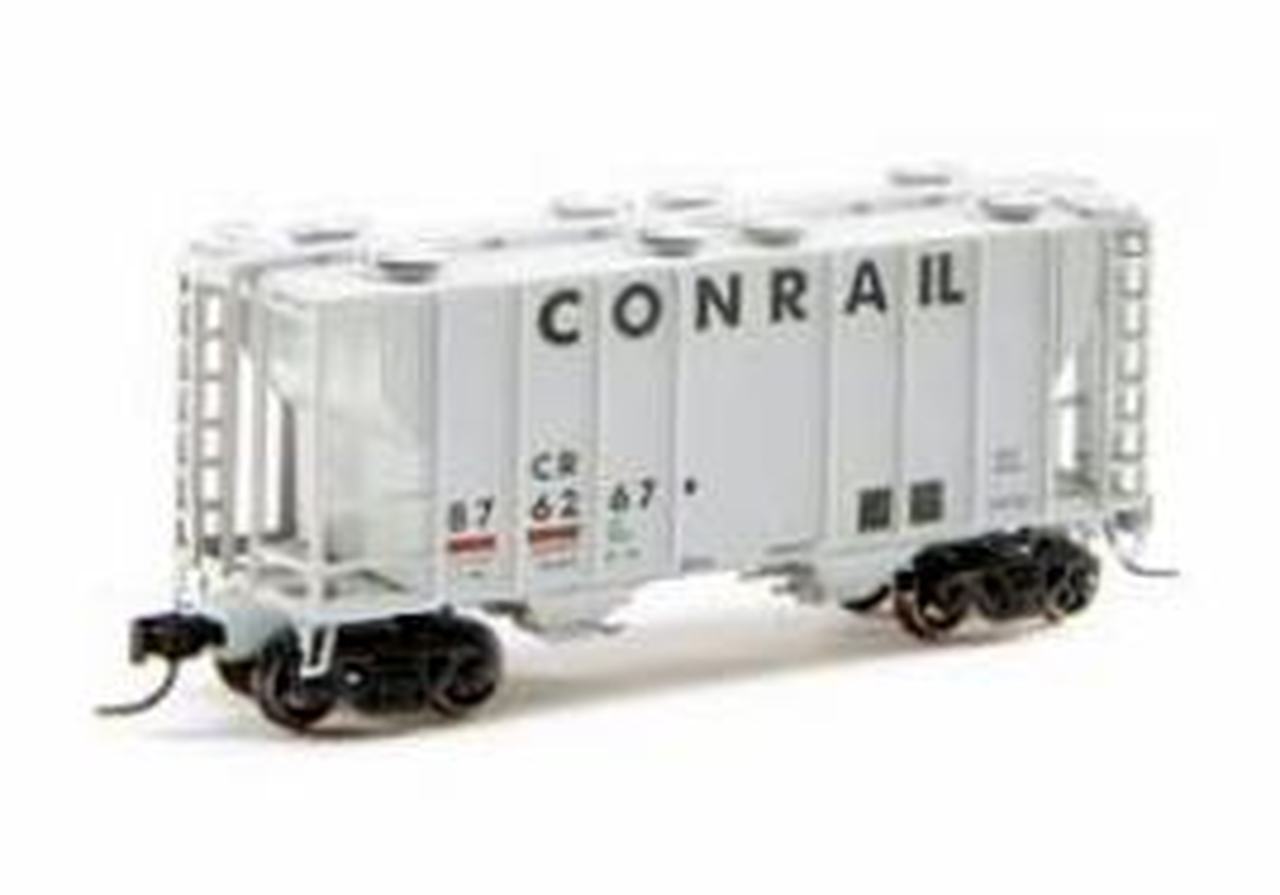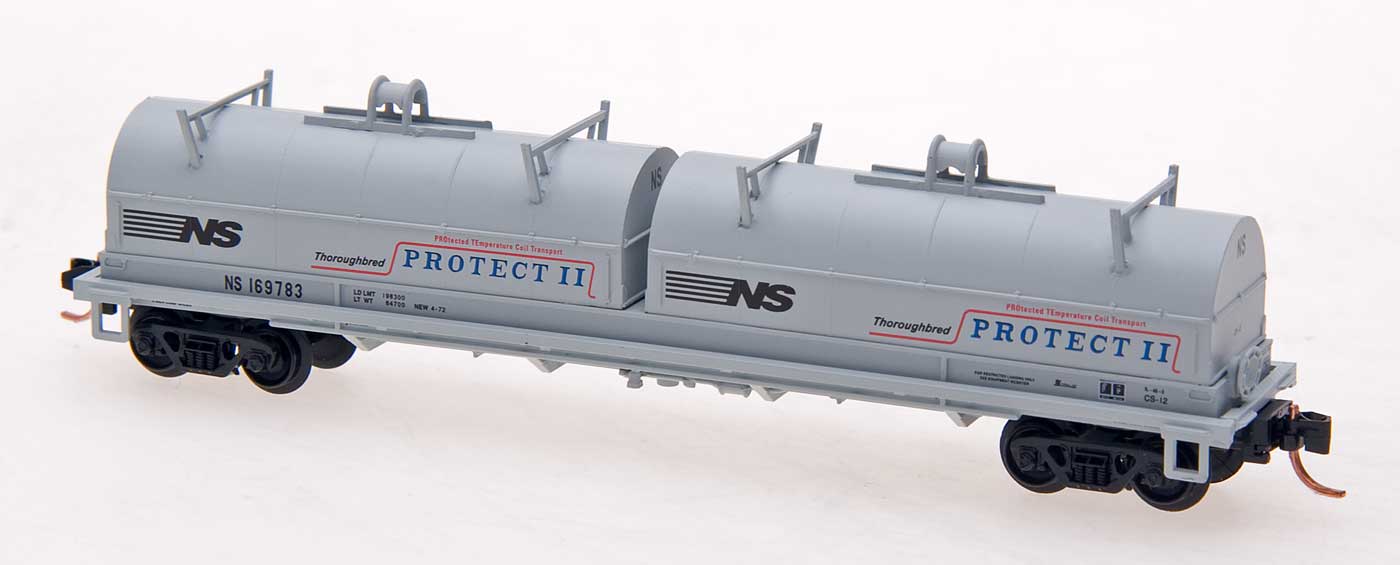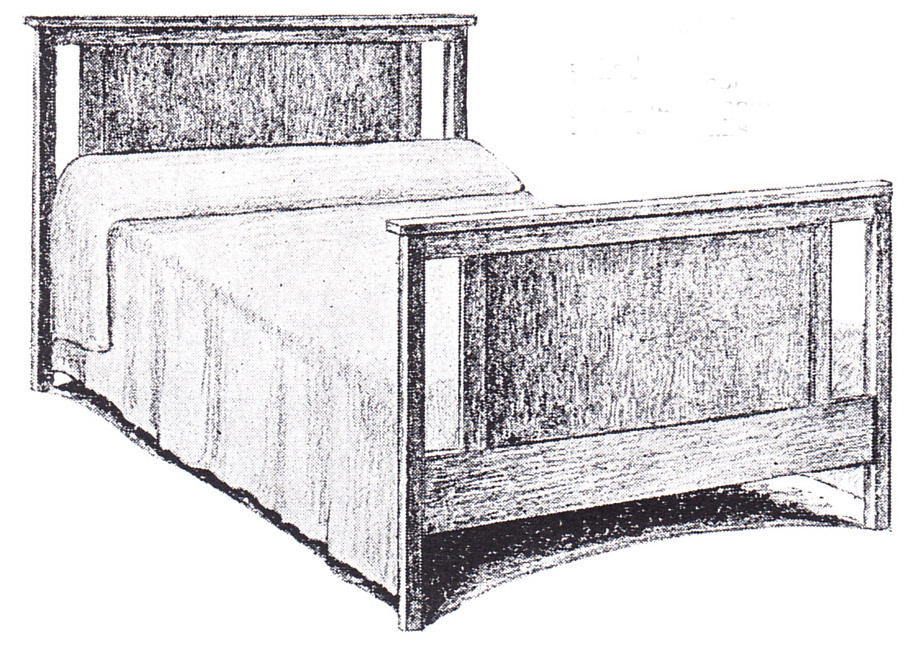Model Information: The "35" series "Offset" Cupola Caboose is an early Atlas body style introduced between 1979 and 1982. It replaced the earlier 6-window version of the offset cupola caboose that was made for Atlas by Roco. The model was first manufactured in Atlas' New Jersey facility but later moved to China. Its cupola is located towards one end of the body hence the nickname "End" or "Offset" Cupola Caboose. This body style has a roofwalk. It has five windows on one side and three on the other (hence it is known as the 8-Window version) as well as two separated windows on each side of the Cupola. It has ladders on each end which do NOT loop over the ends onto the roof.
Prototype History: The origins of the railroad caboose appear to date back to the 1840s when Nat Williams, a conductor of the Auburn & Syracuse Railroad (a later affiliate of the New York Central) became fed up with cramped and uncomfortable quarters to do paperwork (a common job of the conductor, whose responsibility is general oversight and control of a train, passenger or freight), which was usually done in either a free space of a passenger car or combine/baggage car. To fix this problem, Williams found an unused boxcar and using a simple box and barrel, as a seat and desk, set up shop in the car to do his duties. Not only did he find out he had plenty of room to work but also figured that he could use the unused space to store tools (flags, lanterns, spare parts, etc.) and other essentials to have on board whenever needed (such things become commonly stored on the caboose).
Perhaps the most striking feature ever applied to the railroad caboose was its cupola. According to the story, conductor T.B. Watson of the Chicago & North Western in the 1860s reportedly used a hole in a boxcar’s roof (which he was using as a caboose) to get a better vantage point of the train ahead. It is said that Watson was amazed by the view afforded from the position being able to not only see the train ahead but also from all sides, and to the rear as well. He apparently convinced C&NW shop forces to construct a type of open observation box onto an existing singe-level caboose with windows all around where one could sit and view their surroundings. The rest, as they say, is history and the common cupola was born.
Steel Cabooses replaced their wood-sheathed brethren after the second world war when the steel glut made the production and maintenance of steel cabooses far more efficient than wooden models. With the advancement of the End-of-Train device, cabooses slowly began to fall out of favor. However, in the early 2000’s, “shoving platforms” began to appear as a place to safely house a crew when a reverse move was required. Instead of riding on the side of a freight car, the crew member now has a safe place to stand, while guiding the rear of a reverse move.
Perhaps the most striking feature ever applied to the railroad caboose was its cupola. According to the story, conductor T.B. Watson of the Chicago & North Western in the 1860s reportedly used a hole in a boxcar’s roof (which he was using as a caboose) to get a better vantage point of the train ahead. It is said that Watson was amazed by the view afforded from the position being able to not only see the train ahead but also from all sides, and to the rear as well. He apparently convinced C&NW shop forces to construct a type of open observation box onto an existing singe-level caboose with windows all around where one could sit and view their surroundings. The rest, as they say, is history and the common cupola was born.
Steel Cabooses replaced their wood-sheathed brethren after the second world war when the steel glut made the production and maintenance of steel cabooses far more efficient than wooden models. With the advancement of the End-of-Train device, cabooses slowly began to fall out of favor. However, in the early 2000’s, “shoving platforms” began to appear as a place to safely house a crew when a reverse move was required. Instead of riding on the side of a freight car, the crew member now has a safe place to stand, while guiding the rear of a reverse move.
Road Name History: The DM&IR was born in 1937 with the merger of the Duluth Missabe & Northern and the Spirit Lake Transfer Railway. The DM&N had leased the Duluth & Iron Range since 1930 and both were owned by United States Steel. The D&IR was absorbed by the DM&IR in 1938.
The DM&IR ran from the twin ports of Duluth and Superior on the Minnesota-Wisconsin border at the tip of Lake Superior, and Two Harbors, Minnesota north and northwest into the Vermilion and Missabe Ranges of northeast Minnesota. Total mileage was 357. Several of the mainlines are double track and DM&IR operated them with left-hand running. The majority of DM&IR traffic over the decades has been iron ore.
Because DM&IR has traditionally had the heaviest average trains in the nation, their steam fleet had some real monsters. 2-8-8-4 Yellowstones were the biggest. Single Yellowstones were regularly assigned to pull 18,000 ton ore trains on some of the flatter districts. Their biggest yard switchers were 0-10-0’s. DM&IR was the last of the US Steel railroads to dieselize (in 1959) so as the other roads in the US Steel family dieselized, they sent the cream of their steam fleets to the DM&IR. Mikados came from EJ&E. Bessemer & Lake Erie sent their huge Texas-type 2-10-4’s and the Union Railroad sent their 0-10-2’s. That’s not a typo, they had 0-10-2’s. They were used to replace older mallets in pusher service then ended their careers switching the ore docks.
DM&IR dieselized with SD9’s (running short hood forward), SD18’s and ultimately SD38’s. They were one of a handful of Class One railroads to get through the transition era without ever buying cab unit. The SD38 has just 2000 horsepower but has nearly the same tractive effort as an SD40 at low speeds. Many roads bought them to shove trains over the crest in hump yards, but three of the US Steel railroads used them for low speed road service. By the mid-70s, DM&IR had 98 diesels. Many years later, DM&IR was one of the roads to buy rebuilt former SP Tunnel Motors.
Raw iron ore was hauled in 70 ton 24’ long ore cars. The same cars with extension boards are used to haul Taconite. Taconite is low grade ore that is crushed to dust, then combined with bentonite clay and rolled into little balls. It’s less dense than raw ore, doesn’t require further grading, and resists freezing to the cars. This allows all-rail movement of taconite to the steel mills when the Great Lakes freeze over. In the 70s, DM&IR began draw-barring sets of 4 ore cars together which saved on brake hose failure and lowered the tare weigh
t somewhat. They referred to these sets as “mini-quads.” US Steel transferred B&LE and DM&IR to a subsidiary called Transtar. In 2001, the Transtar roads were sold to Great Lakes Transportation. In 2004, DM&IR and B&LE were sold to Canadian National.
The DM&IR ran from the twin ports of Duluth and Superior on the Minnesota-Wisconsin border at the tip of Lake Superior, and Two Harbors, Minnesota north and northwest into the Vermilion and Missabe Ranges of northeast Minnesota. Total mileage was 357. Several of the mainlines are double track and DM&IR operated them with left-hand running. The majority of DM&IR traffic over the decades has been iron ore.
Because DM&IR has traditionally had the heaviest average trains in the nation, their steam fleet had some real monsters. 2-8-8-4 Yellowstones were the biggest. Single Yellowstones were regularly assigned to pull 18,000 ton ore trains on some of the flatter districts. Their biggest yard switchers were 0-10-0’s. DM&IR was the last of the US Steel railroads to dieselize (in 1959) so as the other roads in the US Steel family dieselized, they sent the cream of their steam fleets to the DM&IR. Mikados came from EJ&E. Bessemer & Lake Erie sent their huge Texas-type 2-10-4’s and the Union Railroad sent their 0-10-2’s. That’s not a typo, they had 0-10-2’s. They were used to replace older mallets in pusher service then ended their careers switching the ore docks.
DM&IR dieselized with SD9’s (running short hood forward), SD18’s and ultimately SD38’s. They were one of a handful of Class One railroads to get through the transition era without ever buying cab unit. The SD38 has just 2000 horsepower but has nearly the same tractive effort as an SD40 at low speeds. Many roads bought them to shove trains over the crest in hump yards, but three of the US Steel railroads used them for low speed road service. By the mid-70s, DM&IR had 98 diesels. Many years later, DM&IR was one of the roads to buy rebuilt former SP Tunnel Motors.
Raw iron ore was hauled in 70 ton 24’ long ore cars. The same cars with extension boards are used to haul Taconite. Taconite is low grade ore that is crushed to dust, then combined with bentonite clay and rolled into little balls. It’s less dense than raw ore, doesn’t require further grading, and resists freezing to the cars. This allows all-rail movement of taconite to the steel mills when the Great Lakes freeze over. In the 70s, DM&IR began draw-barring sets of 4 ore cars together which saved on brake hose failure and lowered the tare weigh
t somewhat. They referred to these sets as “mini-quads.” US Steel transferred B&LE and DM&IR to a subsidiary called Transtar. In 2001, the Transtar roads were sold to Great Lakes Transportation. In 2004, DM&IR and B&LE were sold to Canadian National.
Brand/Importer Information: In 1924 Stephan Schaffan, Sr. founded the Atlas Tool Company in Newark, New Jersey. In 1933 his son, Stephan Schaffan, Jr., came to work for his father at the age of sixteen. Steve Jr. built model airplanes as a hobby and frequented a local hobby shop. Being an enterprising young man, he would often ask the owner if there was anything he could do to earn some extra spending money. Tired of listening to his requests, the hobby-store owner threw some model railroad track parts his way and said, "Here, see if you can improve on this".
In those days, railroad modelers had to assemble and build everything from scratch. Steve Jr. created a "switch kit" which sold so well, that the entire family worked on them in the basement at night, while doing business as usual in the machine shop during the day.
Subsequently, Steve Jr. engineered the stapling of rail to fiber track, along with inventing the first practical rail joiner and pre-assembled turnouts and flexible track. All of these products, and more, helped to popularize model railroading and assisted in the creation of a mass-market hobby. The budding entrepreneur quickly outgrew the limitations of a basement and small garage operation. Realizing they could actually make a living selling track and related products, Steve and his father had the first factory built in Hillside, New Jersey at 413 Florence Avenue in 1947. On September 30, 1949, the Atlas Tool Company was officially incorporated as a New Jersey company.
In 1985, Steve was honored posthumously for his inventions by the Model Railroad Industry Association and was inducted into the Model Railroad Industry Hall of Fame in Baltimore, Maryland. In addition, Steve was nominated and entered into the National Model Railroad Association Pioneers of Model Railroading in 1995.
In the early 1990s, the Atlas Tool Company changed its name to Atlas Model Railroad Company, Inc.
In those days, railroad modelers had to assemble and build everything from scratch. Steve Jr. created a "switch kit" which sold so well, that the entire family worked on them in the basement at night, while doing business as usual in the machine shop during the day.
Subsequently, Steve Jr. engineered the stapling of rail to fiber track, along with inventing the first practical rail joiner and pre-assembled turnouts and flexible track. All of these products, and more, helped to popularize model railroading and assisted in the creation of a mass-market hobby. The budding entrepreneur quickly outgrew the limitations of a basement and small garage operation. Realizing they could actually make a living selling track and related products, Steve and his father had the first factory built in Hillside, New Jersey at 413 Florence Avenue in 1947. On September 30, 1949, the Atlas Tool Company was officially incorporated as a New Jersey company.
In 1985, Steve was honored posthumously for his inventions by the Model Railroad Industry Association and was inducted into the Model Railroad Industry Hall of Fame in Baltimore, Maryland. In addition, Steve was nominated and entered into the National Model Railroad Association Pioneers of Model Railroading in 1995.
In the early 1990s, the Atlas Tool Company changed its name to Atlas Model Railroad Company, Inc.
Item created by: trainnut3500 on 2016-08-25 11:04:07. Last edited by gdm on 2018-02-19 16:59:15
If you see errors or missing data in this entry, please feel free to log in and edit it. Anyone with a Gmail account can log in instantly.
If you see errors or missing data in this entry, please feel free to log in and edit it. Anyone with a Gmail account can log in instantly.


